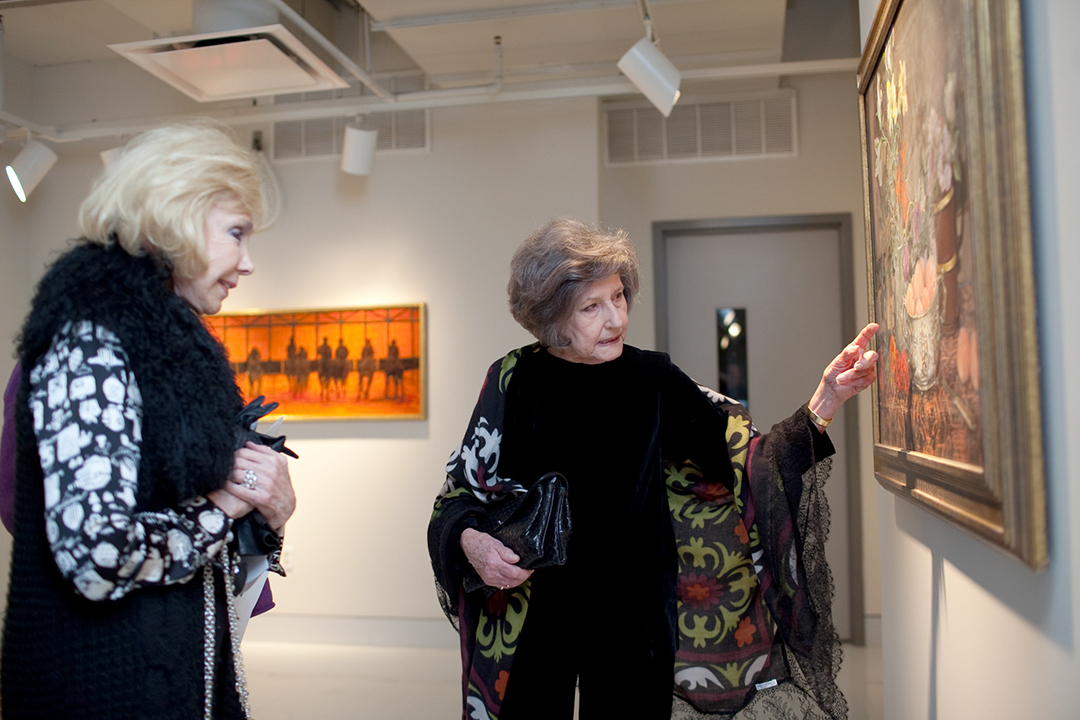The George Washington University community remembers the life of Clarice Smith, B.A. ’76, M.F.A. ’79, Honorary Doctor of Fine Arts ’12, a nationally renowned artist, former GW faculty member and generous philanthropist who, along with her late husband, Robert H. Smith, named The Robert H. and Clarice Smith Hall of Art at GW and were ardent supporters of the D.C. community. She was named a Monumental Alumni during GW’s Bicentennial Celebration.
Ms. Smith died on Dec. 9. She was 88.
An acclaimed painter and portraitist, Ms. Smith’s work was featured in many solo exhibitions in prestigious galleries in cities throughout the United States and internationally, including London, Paris, Zurich, Maastricht and Jerusalem. Her museum exhibitions included solo shows at the National Museum of Women in the Arts, Virginia Museum of Fine Arts, the New-York Historical Society and the Kreeger Museum in Washington, D.C. One of her paintings, “Big Race” (2001), is in the permanent collection of the Smithsonian American Art Museum.
Ms. Smith was a member of the GW faculty from 1980 to 1987, teaching watercolor and portrait painting in the Department of Fine Arts and Art History. In 2012, she received an Honorary Doctor of Fine Arts from GW.
“I was privileged to have known her as an artist, wise mentor and curatorial collaborator throughout my GW career,” said Lenore D. Miller, M.F.A. ’72, who retired as GW’s director of university art galleries and chief curator in 2020. “She was a remarkable traditional painter whose training at GW enabled her to capture the pure joy she experienced in the visual world. I will be forever grateful to Clarice for sharing her grace, elegance and accomplishments with so many friends and colleagues.”
Ms. Smith was best known in the art world as a traditional painter, trained through life drawing and works in oil. Her works include portraits, florals, landscapes, still life’s and scenes of horses and sport. She expanded her artistic endeavors to include working with stained glass and was commissioned by the New York Historical Society to create a stained glass window for an oculus in their Grand Hall. Recently, Ms. Smith added book illustrator to her list of credits working with her son, David Bruce Smith, B.A. ’79, a former member of GW’s Board of Trustees, on a well-received series of historical books for children.
Citing inspiration from painters like James McNeil Whistler, Edouard Manet and John Singer Sargent, many of Ms. Smith’s compositions depicted the people and places around her. “I paint the scenes of my life,” she told GW Today in 2013 at the opening of her “Clarice Smith: Captured Moments” exhibition at the Luther W. Brady Art Gallery. “I’m not interested in just painting a pretty flower—I want to invoke a memory or a feeling.”
In addition to naming the Smith Hall of Art, Ms. Smith and her family have been generous benefactors to GW and other institutions. Their support spanned numerous areas of the university, including student aid, arts-related initiatives, Jewish academic and cultural programs and the Charles E. Smith Athletic Center, which was endowed by Ms. Smith’s father-in-law.
Ms. Smith’s family connections span several generations at GW. In addition to her son David Bruce Smith, her late son Steven Craig Smith, B.B.A. ’79, and her granddaughter Alexandra M. Lipp, B.A. ’15, are both GW alumni. Ms. Smith’s sister-in-law Arlene R. Kogod, ATT ’71, ‘76, whose husband is Robert P. Kogod, also attended GW.
“Clarice’s passing is a huge loss for the entire D.C. area community,” said Donna Arbide, GW’s vice president of development and alumni relations. Ms. Arbide added that Ms. Smith was one of the very first GW supporters she had the pleasure of meeting because of the entire family’s connection to the university. “We had tea at the president’s house the week I started at GW. This also gave me my first glimpse of Clarice’s prodigious talent, because we sat beneath one of her beautiful paintings, 'Hydrangeas III,' that hangs in the parlor,” Ms. Arbide said. “The family has an incredible legacy of giving and leadership in D.C. that spans generations, and she will be greatly missed at GW.”


